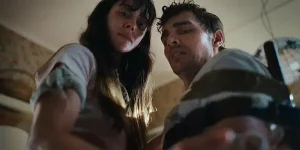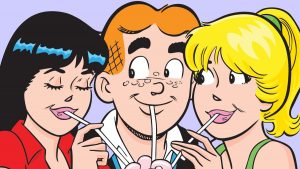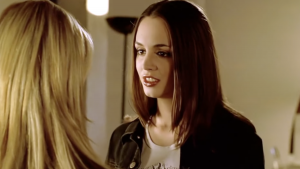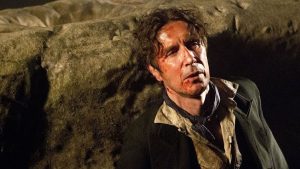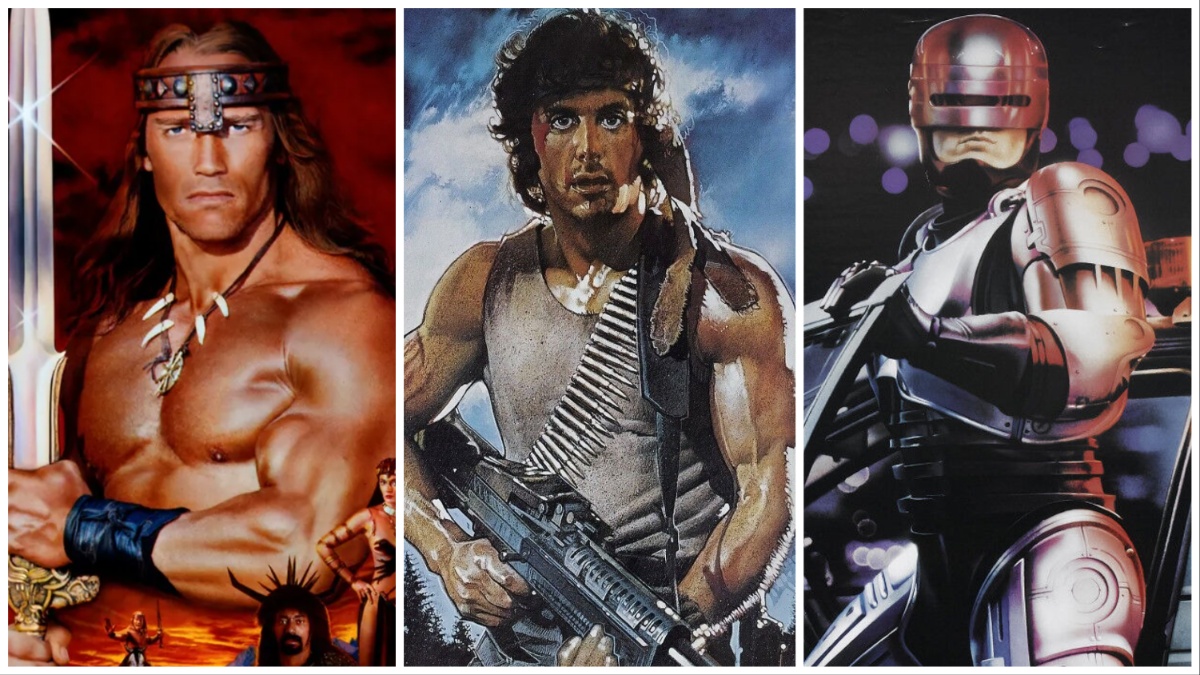
The late 20th century was a wild time to be a kid immersed in the world of pop culture. It was the period that produced Jessica Rabbit, a cartoon character you felt embarrassed to watch with your parents, and a time when stores regularly stocked movie tie-in toys linked to “kid-friendly” fare like Aliens and Terminator 2.
It seemed like nothing was off the table and that was certainly the case in the world of cartoons. Eager to cash in on the appeal of cinematic properties in a way that would give even the MCU pause for thought, a glut of animated shows inspired by movies featuring torture, nudity, beheadings, and buckets of toxic waste found their way onto the small screen. In most cases, the cartoons spawned rarely stuck around for long, but today they stand as examples of a weird and wonderful chapter in the history of small screen entertainment. Here are 10 of the strangest.
Rambo: The Force of Freedom
Originally airing in 1986, Rambo: The Force of Freedom completed John Rambo’s transformation from First Blood’s troubled Vietnam veteran to the greased up muscle-bound killing machine in the lamentably gung-ho Rambo: First Blood Part II. Toy company Coleco shelled out an eye-watering $15 million to produce the initial 65-episode run for syndication, alongside a line of toys. Any trace of Rambo’s PTSD or history in the Vietnam War was erased in favor of a show that was a clear G.I. Joe rip-off, right down to every episode ending with a moral message.
Each week Rambo led a special unit called The Force of Freedom in a battle against the paramilitary terrorist organization S.A.V.A.G.E. (Specialist-Administrators of Vengeance, Anarchy and Global Extortion) and the show’s main villain, General Warhawk. With episodes focusing on conflicts in fictional countries like Tierra Libre, and Bagdinia, the show was painfully on the nose and, unfortunately, failed to find an audience.
RoboCop
You might have thought one of the most violent films ever made would struggle to be adapted into something appropriate for kids but, to quote Jeff Goldblum in Jurassic Park, “life finds a way.” Or rather, in this instance, Marvel Productions did. Though much of the violence was jettisoned from the RoboCop cartoon series, which was released in 1988, a year after the original film, the opening credits still featured a brief sequence of Alex Murphy being gunned down by Clarence Bodicker and his gang. In fact, in the universe of the cartoon, they were still very much alive and popped up in one episode.
Lasers replaced guns while most episodes saw RoboCop battle other ED-209-like creations, as well as corrupt police officers, save for one odd episode focusing on a KKK-style gang called “The Brotherhood,” who wanted to eradicate robots of any kind. Originally slated for a 13-episode run, just 12 were produced after Marvel Productions opted to spend the budget set aside for the finale on an X-Men animated series pilot. It was probably a wise move.
Police Academy
The Police Academy movies were already well past their expiration date by the time this animated spin-off arrived in September 1988, a few months on from the release of Police Academy 5: Assignment Miami Beach and a few months before Police Academy 6: City Under Siege. Though Steve Guttenberg had bailed after the fourth entry in the franchise, the character of Mahoney returned for the animated series alongside old “favorites” like High Tower, Laverne, Tackleberry, and the Sound Effects guy. This time, however, they had reinforcements in the form of the Canine Corps, a group of talking police dogs who were largely there to paper over the cracks left after much of the nudity and inappropriate jokes that made the films so strangely popular were removed.
Featuring a theme song performed by hip-hop trio the Fat Boys and memorable for featuring a villain called “The Kingpin,” who looked and sounded a whole lot like the Marvel character, the show proved strangely popular in Europe and Italy, in particular, and ran for two seasons before Police Academy fatigue finally set in.
Highlander: The Animated Series
In the Highlander films, Christopher Lambert’s character Connor MacLeod can often be heard to remark that “there can be only one.” That’s certainly not proven to be the case for the Highlander franchise which, to date, has spawned six films, two TV shows, an upcoming reboot, and two seasons of this unusual cartoon.
Set in the 27th century and briefly featuring Connor, who ends up being killed, but thankfully not beheaded, the show borrowed heavily from the first movie with a plot that sees Connor’s nephew, Quentin MacLeod, killed then resurrected to serve as a Highlander under the tutelage of Ramirez. A franchise already steeped in confusing and contradictory mythology, Highlander: The Animated Series introduced the concept of Jettators, immortals who have renounced their quest to be “the one” and win “The Game.” Instead they wish to help mankind. The problem is, a few bad apples among the Highlanders decided against becoming Jettators, creating the series’ central conflict.
Confusing? Yes, but the show still made it to two seasons and got a video game spinoff titled Highlander: The Last of the MacLeods on Atari Jaguar CD.
Toxic Crusaders
You would think a cartoon inspired by an extremely violent horror film featuring copious amounts of nudity, and from a studio known for the likes of Surf Nazis Must Die, couldn’t and shouldn’t make it to the small screen. Yet, against all odds, Toxic Crusaders kind of worked..
Tapping into the trend for environmentally focused cartoons created by shows like Captain Planet, the series toned down much of what made the Toxic Avenger movies so shocking in order to create a show about a group of misfit superheroes led by Melvin Junko’s nerd-turned-grotesque mutant with super powers, Toxie. Joined by a sentient mop, each week Toxie and his crew battled against a series of villains including Smogulans, an alien race who need pollution in order to survive. Despite running for just 13 episodes, the show’s slyly adult-orientated jokes and status as a small screen oddity have ensured cult status.
Conan the Adventurer
Conan the Barbarian may have originated from Robert E. Howard’s classic pulp magazine stories, but the 1992 cartoon was undoubtedly buoyed by the success of Arnold Schwarzenegger’s previous two outings at the titular barbarian.
It certainly plays out like a kid-friendly version of the first Conan movie. While there’s no Thulsa Doom, the series does retain the film’s Snake Cult, though in this version they stop short of murdering Conan’s family with their leader, Wrath-Amon, opting to turn them to stone instead. Swearing in the name of “Crom” to try and find a way to release them, Conan heads off in search of revenge and soon amasses a gang of sidekicks to help him in his quest.
Conan cut a decidedly ruthless figure in previous incarnations of the character. He killed, he stole, and he generally philandered. That wasn’t going to fly in a cartoon for kids though, with this version adopting a more moralistic stance on issues. It may have made him an anachronism, but there was something heartening about Conan doing things like refusing to join a gang of pirates because they steal. No one was ever truly murdered either—even the serpent men were “banished” when struck by a word rather than actually killed. Running for two seasons of 65 episodes, the show was enough of a success to spark a follow-up, Conan and the Young Warriors. Unfortunately, that series was less well-received and ended after just 13 episodes.
Roughnecks: Starship Troopers Chronicles
Something of an outlier due to the fact it aired in 1999, the sight of Roughnecks: Starship Troopers Chronicles in the TV listings would still have been enough to prompt more than a few double takes among those who watched the original film and recalled scenes such as the communal shower or the moment a man’s brain is sucked from his skull. Fortunately, all of the violence and nudity that made the film such a typical Paul Verhoeven production was removed from this CGI animated series. Unfortunately, all of the biting satire and political aspects that made the film such a typical Paul Verhoeven production were also removed, even though Verhoeven served as an executive producer.
Instead the series focused on “Razak’s Roughnecks” a mobile infantry squad embroiled in the war between humanity and an extraterrestrial “bug” race of Arachnids, similar to the ones found in the movie but wholly less effective. Featuring some striking character design for the period, including power armor suits with episodes focusing on specific missions, the show might have garnered more of a following, but a series of disputes and scheduling problems diluted any fan momentum, while plans for a finale featuring a titanic battle against the bug forces on Earth were put on ice after production was halted before the series was supposed to end.
The Real Ghostbusters
Ghostbusters may not strictly be an R-rated movie, but try telling that to any mom or dad out there who was forced to explain why Ray Stantz’s trousers came open when that ghost was floating over him. My parents told me it was because he had had a big meal and was very full. I’m not sure today’s kids are quite so naive. In any case, the presence of Zuul in Dana Barrett’s apartment was enough to put me off looking inside fridges for a long time (I’ve been cured of that since, of course) while the hellhound that stalks Louis Tully was similarly scary enough. Whatever the case, the blue humor and scares at the heart of Ghostbusters would probably prevent it from becoming a cartoon today. Thankfully, Columbia Pictures Television and DIC Enterprises decided differently and it’s just as well they did.
Forced to tweak the name due to the existence of another Filmnation animated series called Ghost Busters, The Real Ghostbusters ditched Dana and turned Slimer into a sidekick while Stantz became a redhead and Egon was given a wild new blond hairstyle. That didn’t matter though with the show’s inventive ghost-of-the-week storylines helping it rack up 140 episodes over seven seasons. Here are the scariest ones.
Beetlejuice
While the source material continues to enjoy classic status, with a long awaited sequel on the way, it’s often forgotten that the animated Beetlejuice series which, aired a year after the original film hit multiplexes in 1988, was a bonafide hit. In fact, the cartoon spawned 94 episodes that aired across four seasons while also claiming a daytime Emmy. Produced by Tim Burton, the series ejected some of the more macabre and grotesque elements of the movie in favor of a series that focused in on the colorfully inventive characters.
For example, the “Afterlife” was renamed the “Neitherworld” here, helping to avoid any difficult conversations with parents. The film’s main characters, the Maitlands, were also entirely jettisoned while Beetlejuice was recast from malevolent foe to mischievous best friend of Winona Ryder’s Lydia from the original film. Their adventures largely involved Lydia getting Beetlejuice out of whatever jam he’d gotten himself into this week, but there were enough quirks and general inventiveness to keep fans entertained.
Parodies featured regularly throughout the show’s run with one notable episode, Brides of Funkenstein, seeing Lydia and her friends form a band. The episode was notable for the fact it was originally pitched by a teenage fan of the series and for featuring a pitch perfect parody of Nirvana’s “Smells Like Teen Spirit.”
Attack of the Killer Tomatoes
Despite sharing the same name as the original 1978 film, the Attack of the Killer Tomatoes animated series had more in common with its belated sequel, 1988’s Return of the Killer Tomatoes!, which is best known for starring George Clooney in an early movie role.
Picking up where the second film left off, the series initially centered on pizza boy Chad Finletter and his tomato-turned-human girlfriend Tara Boumday’s efforts to thwart the villainous Dr. Putrid T. Gangreen. However, things took a surprise turn in the show’s second season when, after an experiment gone wrong, Dr. Gangreen is forced to team up with Finletter and Boumday against a gang of twice-mutated tomatoes who have taken over the world. Despite the formulaic setup, the Attack of the Killer Tomatoes cartoon did occasionally strike a subversive note, most notably with the character of the Censor Lady, who occasionally appeared to stop other characters committing violent acts and to break the fourth wall and warn the audience. Another character called the “Tomato Guy,” meanwhile, regularly appeared to simply catch someone off-guard by shouting the word “tomato.” It was odd.
The post 10 R-Rated or Adult-Skewing Movies That Were Turned into Children’s Cartoons appeared first on Den of Geek.




